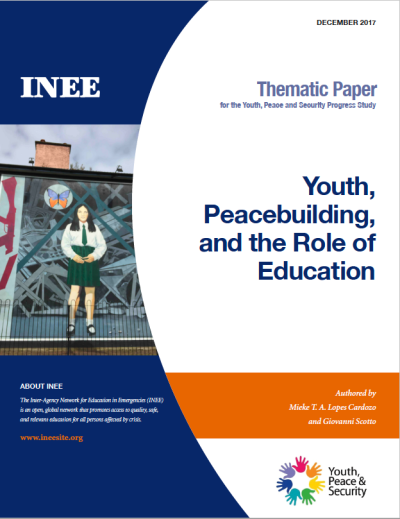Education for Peacebuilding
With the Sustainable Development Goals (SDGs) officially coming into force in January 2016, there is renewed international commitment for and optimism towards ending global poverty during the next two decades. Simultaneously, however, there is growing concern that protracted conflicts and an increase in natural disasters threaten to undo the gains made to date.
In light of Sustainable Development Goal 16 on promoting peaceful and inclusive societies, as well as Goal 4 (inclusive and equitable quality education), Goal 5 (gender equality), Goal 8 (decent work and economic growth), and Goal 10 (reduced inequalities) – there is a strong global imperative for understanding the essential connection between positive human development outcomes and ending recurrent cycles of conflict and violence. This was further stressed in three recent Peace and Security Reviews (UN Peacebuilding Review, Peace Operations Review, and SC Resolution 1325 Review), as well as the recent Sustaining Peace Resolutions endorsed by both the General Assembly (A/RES/70/262) and Security Council (S/RES/2282-2016), which called for all UN agencies to contribute to sustaining peace; to leverage social services for peacebuilding; and for mainstreaming and focus on the role of women in peacebuilding. Yet, despite their recognized contribution to restoring stability in the aftermath of violence, there is no common understanding of precisely how programs addressing administrative and social services can aid peacebuilding.
Education social services have historically been used both as a means to catalyze conflict, and to build peace. Education becomes a driver of conflict when education services are made accessible only for some, and not for everyone. Where education services are poor in quality, irrelevant for employability, or abilities to cope effectively in challenging circumstances, citizens respond with frustration and resentment. Where education systems are being hijacked to polarize society, or where education instruments and tools communicate disrespect or discriminate against minority groups, education naturally turns into a tool of divisiveness. On the other hand, education services that are equitably accessible; that are of quality and relevant; that reinforce a common narrative; that strengthen intergroup relationships and identities; and that are fairly administered across constituent groups education do foster both vertical and horizontal social cohesion.
Key Statistics and Messages on Education for Peacebuilding
- Education and inequality: research comparing education equality data and violent conflict data from nearly 100 countries over 50 years found robust evidence that the likelihood of violent conflict doubles for countries with high levels of intergroup inequality in education, after controlling for known conflict risk factors, such as wealth, political regime, geography, etc. The research also suggests that greater education equality between male and female students decreases the likelihood of violent conflict by as much as 37 per cent.
-
Education sector policy and planning can contribute to building sustainable peace through: redistribution (fair distribution of education access, resources, opportunities); recognition (respecting diversity and identity through education); representation (ensuring equitable participation in decision making at all levels); and reconciliation (leveraging education to deal with the legacy of past human rights violations, or addressing historical or contemporary injustices).
-
Transitional justice and education: In societies coming to terms with an abusive past, Transitional Justice efforts aiming to strengthen the rule of law, address grievances among affected communities, and prevent the recurrence of human rights violations, can benefit from education in two areas. First, education should contribute to developing children’s abilities and skills for participating in a country’s productive and sociopolitical realms. Second, in a post-war society, education is charged with the task of enhancing the capacity of citizens, especially—but not only—adolescents and children, to think critically about the present and the past, so they can foresee and construct a better future.
- Early Childhood Development (ECD) services can prevent violence at the micro-level: Children who have benefitted from proper stimulation and nurturance demonstrate healthy biological stress systems, secure early attachment, as well as healthy socio-emotional and cognitive development, resulting in reduced disposition to violence later in life. All developmental domains are compromised, however, if children are affected by direct violence (living in settings of war, domestic violence, etc.) or structural violence (inequality, poverty, etc.).
This collection was developed with the support of Friedrich Affolter, an Education Peacebuilding Expert for UNICEF.




